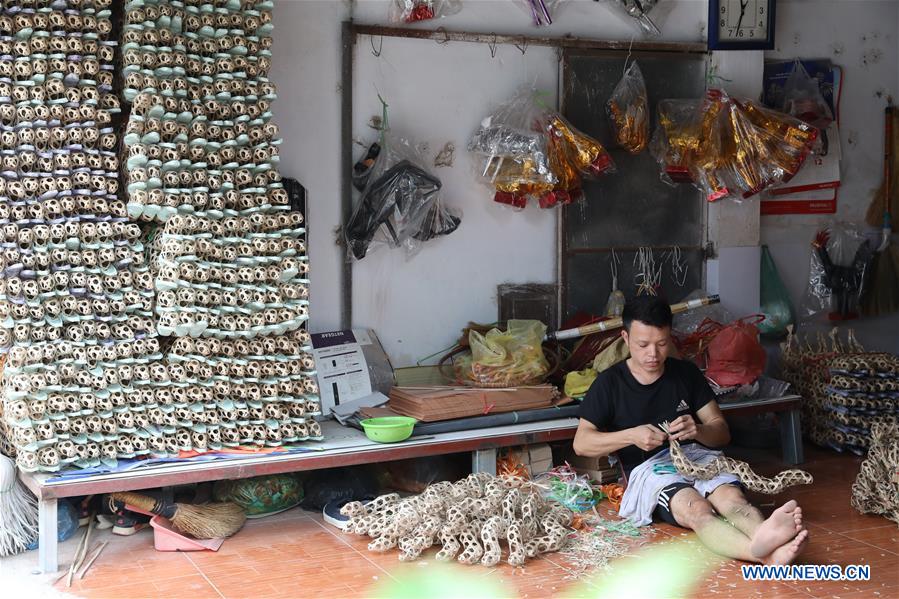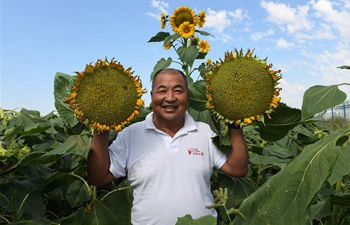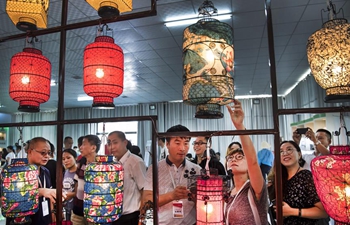
by Tao Jun, Bui Long
HANOI, Aug. 24 (Xinhua) -- Big trucks laden with modern goods, including flat-screen TV sets, smart phones including iPhones, air-conditioners and fashionable handbags, have been running in and out a traditional craft village in northern Vietnam recently, but all the items are made manually from paper and carton, and are to serve the deceased.
On Tuesday, three days before the Hungry Ghost Festival, also known as the Yulan or Zhongyuan Festival, all members of the extended family of Nguyen Thi Mi in Dao Tu village, Song Ho commune, Bac Ninh province, located around 35 km northeast of the capital city of Hanoi, were as busy as bees, making paper votive from 6:00 a.m. to 11:00 p.m. local time.
Mi, a 70-year-old woman of small stature, sat in a spacious room full of paper, cartons and votive objects, meticulously making men's and women's underwear from soft white paper. Sitting next to Mi, her 18-year-old granddaughter named Ha was swiftly producing shirts from harder paper with pink striped lines, and Ha's teenage nephew was placing the underwear in the shirts.
"Our family specializes in making clothes. And we buy other paper items from our villagers and resell them to traders from other provinces," the woman told Xinhua on Tuesday, while her son and daughter-in-law loaded paper clothes, horses, elephants, boats, cars, washing machines and villas on a seven-ton truck in front of their house.
"This truck is very big, laden with too many bulky products, but in fact they are very light and worth only several millions of Vietnamese dong (around 100 U.S. dollars)," Mi's daughter-in-law named Hue told Xinhua, using her bare hand to wipe sweat from her forehead under the direct sunlight.
After completing the loading, Hue and her barebacked husband entered their house to join with other family members in the process of cutting paper and carton into pieces, arranging them into different shapes, using homemade starch glue to stick the pieces together, and drying them under the sun.
According to Mi, she can make some 200 sets of underwear a day, but her son, grandson or great grandson can produce 300-400 sets of clothes, including underwear, shirts and trousers, which sell for 10,000 Vietnamese dong (0.4 U.S. dollars) per set.
"Because the demand for votive items surges before the Hungry Ghost Festival, and we have to work all day, and even at night. My eyes have to stick to the clothes all the time, so I have frequent eyestrain. However, my wage is very modest, just 2-3 million Vietnamese dong (87-130 U.S. dollars) a month," Mi sighed, adjusting her far-sighted glasses.
Young people can earn bigger wages from churning out more products in the same period and making more complicated items with higher price-tags such as dragon boats, horses, cars and motorbikes, Mi's married nephew explained, noting that it takes them between three to four hours to produce a big horse worth over 100,000 Vietnamese dong (4.3 U.S. dollars), and around two hours to make a TV set worth 40,000 Vietnamese dong (1.7 U.S. dollars).
However, making big items such as elephants, horses and dragon boats, require more materials and higher degrees of skillfulness.
"My younger sister is in charge of turning bamboo sections into slender small lathes and knitting them into forms of big horses. My niece cuts colored paper into big and small pieces, and then I glue them to the bamboo forms," a middle-age woman named Nguyen Thi Cuc told Xinhua on Tuesday.
Local artisans have to complete at least five stages to churn out a medium-sized horse from bamboo and paper, but the horse is sold for only 25,000 Vietnamese dong (1.1 U.S. dollars) at their houses, Cuc said.
"Before the Hungry Ghost Festival, we sell some 500 paper horses a day. It costs only 25,000 Vietnamese dong (nearly 1.1 U.S. dollars) for a medium-sized horse, and 100,000 Vietnamese dong (4.3 U.S. dollars) for a large-sized horse. But the sales prices in other cities can double or treble in other provinces," a young man named Nguyen Huu Tung told Xinhua on Tuesday, as he loaded dozens of horses to his big truck destined for Hanoi.
According to Tung, in the past, people often bought horses, elephants and dragon boats, believing that their dead relatives could ride them in the afterlife, but now buyers tend to prefer modern means of transport such as motorcycles, cars and aircraft.
Local artisans are rapidly catching up with this new trend. Lai Dac Hung, a 45-year-old man in Dao Tu village, said many villagers have produced less traditional costumes, ancient banknotes, gold ingots and elephants from paper, and made more contemporary items such as fashionable shirts and ties, modern banknotes, luxury cars and beautiful villas, even domestic servants from paper and cartons.
"Normally, my wife and I make 300 piles of votive banknotes a day, and use a cart to transport them to traders in the province. Now, when the Hungry Ghost Festival is nearing, we sell 500 piles. But we will shift to production of modern items soon because they sell well in Vietnam and some other Asian countries," Hung said.
Paper votive items produced in Song Ho commune are sold to many Vietnamese cities and provinces, and are even exported to China's Hong Kong, China's Taiwan and South Korea, Nguyen Xuan Dinh, chairman of the communal People's Committee, told Xinhua on Tuesday.
"Song Ho has a land area of over 3.7 square km and a population of approximately 6,600 people living in 1,500 households. All of the villages in our commune make paper votive objects. Specifically, in Dao Tu and the nearby village of Dong Khe, more than 90 percent of their population engage in the traditional craft, which is believed to have begun more than five centuries ago," said Dinh.
According to the chairman, unlike Westerners, Vietnamese people attach more importance to death-related anniversaries, and they pay their respects to the deceased by offering votive paper objects on various occasions, especially the Hungry Ghost Festival, which falls on the 15th day of July according to the lunar month (on Aug. 25, 2018), and the Lunar New Year festival (often in February).
Activities during the Hungry Ghost Festival often include preparing ritualistic food offerings, burning incense, burning joss paper, and offering votive paper items for the visiting spirits of people's ancestors and strangers.
However, it is waste of money if people burn too many votive items, Dinh said. According to many producers and traders in Vietnam, local people burn around 50,000 tons of joss paper and votive paper objects worth many millions of U.S. dollars each year.
"We will encourage local people to diversify their products, such as artistic handicrafts made from second-hand paper or cartons, which are environmentally friendly," the chairman said, smiling.











